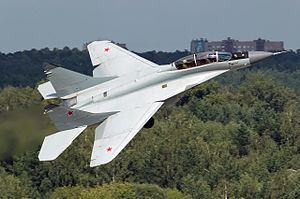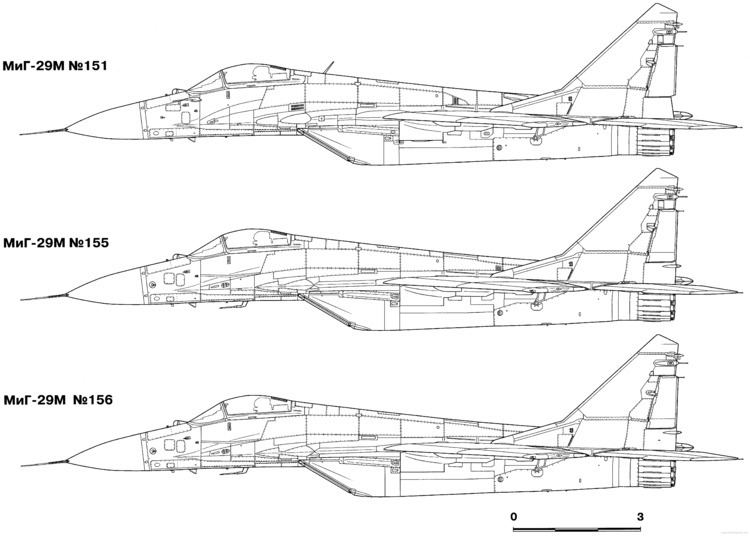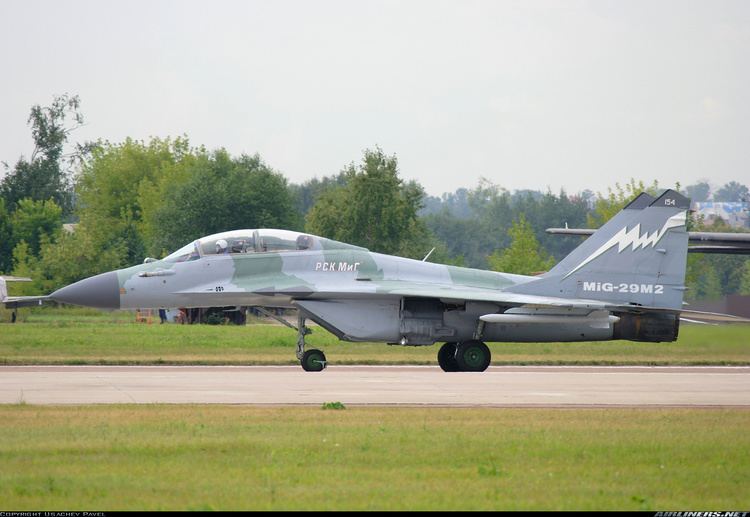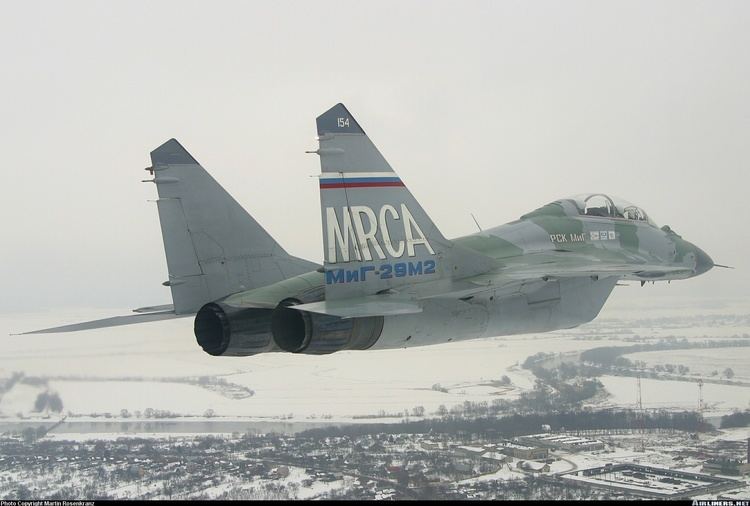Top speed 2,600 km/h Weight 13,380 kg Length 17 m | Range 2,000 km Wingspan 11 m | |
 | ||
Unit cost 24,500,000–27,000,000 USD (2013) | ||
The Mikoyan MiG-29M (Russian: Микоян МиГ-33, NATO reporting name "Fulcrum-E") is a fighter aircraft that was developed as an advanced variant of the Mikoyan MiG-29 (NATO: "Fulcrum") fighter. Formerly named "MiG-33", it was originally designed by Mikoyan in the Soviet Union during the mid-1980s.
Contents
- Development
- MiG 33
- Design
- Possible operators
- Variants
- Operators
- Former operators
- Specifications MiG 29MM2
- References

Development

In the mid-1980s, a development of the original MiG-29 was proposed to meet the Soviet western front line requirement. It was required to be a multirole fighter for the front line defensive air force to gain offensive strike ability. This development resulted in a single seat and a double seat variant. The proposal was then grounded as a result of shifts in military strategy. The model was named "MiG-33" and later received the MiG-29ME designation for export market in the mid-1990s. A twin seat model of the standard, commonly known as the MiG-29MRCA, was the MAPO-MiG's primary contender for many international fighter aircraft bids, later evolved into the Mikoyan MiG-35. Six of these models were built before 1990. They were constantly upgraded with various components and one received experimental vector thrust engines which eventually became the MiG-29OVT. The model was again renamed as MiG-29M. The MiG-29M/M2 now belongs to the "new unified family" instead of the "MiG-29 fighters family" which comprise the older variants.
MiG-33

During the early 1990s, it became briefly popular for Sukhoi and Mikoyan to assign new designations for upgraded models to make them appear "new and improved" instead of just "improved". The VVS did not accept these marketing designations and most were soon dropped. Following Sukhoi's initiative in this approach, Mikoyan's first such offering was the MiG-29ME, which first publicly appeared as the MiG-33 at the 1994 Farnborough Airshow. The MiG-29ME was the export version of the MiG-29M (Product 9.15) "Super Fulcrum", a comprehensively upgraded, fully multirole version of the MiG-29.

Although the MiG-33 designation was soon dropped, the MiG-29M may have merited a new designation in that it is in many ways a thoroughly redesigned version of the MiG-29. While external differences are few, the MiG-29M was a fully "multifunctional" fighter capable of performing air-to-ground combat with precision-guided munitions (PGMs), along with air-to-air roles of earlier MiG-29 versions. Pilot-aircraft interfaces in the cockpit were also improved and a wide range of new-generation equipment installed. The aircraft's internal fuel capacity was also increased to add combat range.
Design

The MiG-29M/M2 aircraft is a revision of the basic MiG-29. It achieved a more robust multi-role capability with enhanced use of air-to-air and air-to-ground high-precision weapons. It also featured considerably increased combat range owing to an increase in its internal fuel capacity.
A few changes took place during the aircraft's development. The redesigned airframe was constructed from a lightweight Aluminium-lithium alloy to increase thrust-to-weight ratio. Air intake ramps' geometry was revised, the upper intake louvers removed to make way for more fuel in the LERXs, mesh screens introduced to prevent foreign object damage (FOD) and enlarged inlet dimensions for higher airflow.
The RD-33MK, the latest revision of the RD-33, has 7% more power in comparison to the baseline model due to the usage of modern materials on the cooled blades, and provides a thrust of 9,000 kgf. In response to longtime criticism, the new engines are smokeless and contain improvements that reduce its infrared visibility. Thrust vectoring nozzles are now offered upon customer’s request. Dry weight is 1,145 kilograms (2,520 lb) compared to the baseline model through modern materials used on the cooled blades, although it retains the same length and maximum diameter. Incorporated is an infrared and optical signature visibility reduction systems. Service life has been increased to 4,000 hours.
The aircraft is built with an in-flight-refueling (IFR) probe and is able to carry three fuel drop tanks. The redesigned airframe also significantly increased internal fuel capacity in the dorsal spine and LERXs fuel tanks. These give the aircraft of single seat an operation range of 2,000 km with internal fuel, 3,200 km with three fuel drop tanks, and 6,000 km with three drop tanks and in-flight-refueling.
The cockpit has been redesigned to incorporate contemporary features. While some analogue instruments have been retained, two monochrome liquid crystal (LCD) multi-function displays (MFD) have been introduced and new weapon controls have been incorporated in a HOTAS concept. Other new features include the Zhuk-ME radar, an infra-red search and track (IRST) system and a helmet-mounted target designation system (early head-mounted display).
Main upgrades consists of the Zhuk-ME pulse-Doppler airborne radar, along with revised IRST systems, helmet-mounted target designation system and electronic countermeasures. New radar capable of detecting air targets at ranges up to 120 km, track-while-scan of ten targets and attack of four targets at a time.
Possible operators
The Syrian Air Force ordered 24 MiG-29M/M2s. In July 2012 at the Farnborough Air Show, Russia announced it would not deliver weapons, including combat aircraft, to Syria until the crisis there ends. On 31 May 2013, RSK MiG's director general, Sergei Korotkov, said that the company plans to sign a contract to deliver "more than 10" MiG-29 M/M2 with Syria and that Syrian delegation was in Moscow to discuss terms and deadlines of a new contract supplying fighter jets to Syria.
The Serbian Air Force has expressed its intention to buy 12 MIG-29M/M2s to replace aging MiG-21s. Media reports indicate that Serbia intends to purchase 6 MiG-29M/M2 aircraft.
In November 2013, it was reported that Egypt and Russia were negotiating an order of 24 MiG-29M/M2s for the Egyptian Air Force. In April 2015, Egypt instead signed a contract, worth up to $2 billion, for 50 MiG-35 fighters.
Variants
Advanced single-seat multi-role variant, with a redesigned airframe, mechanical flight controls replaced by a fly-by-wire system and powered by enhanced RD-33 ser.3M engines. NATO reporting code is 'Fulcrum-E'.
Two-seat training variant of the MiG-29M. Never built. Effectively continued under the designation 'MiG-29M2'.
An upgrade package of the first-generation MiG-29s (9.12 to 9.13) containing many enhancements intended for the MiG-29M. Additional fuel tanks in a further enlarged spine provide a maximum flight range of 2,100 km on internal fuel. The cockpit has an enhanced HOTAS design, two 152 × 203 mm (6 × 8 inch) colour liquid crystal MFDs and two smaller monochrome LCDs. The upgraded Zhuk-ME radar provides similar features to the MiG-29M. The power plant are upgraded RD-33 ser.3 engines with afterburning thrust rated the same at 8,300 kgf (81.4 kN) each. The weapons load was increased to 4,500 kg on six underwing and one ventral hardpoints, with similar weapon choices as for the MiG-29M variant. The upgraded aircraft has also a painted path for non-Russian origin avionics and weapons.
SMT standard upgrade for the MiG-29UB. Namely users, Algeria and Yemen.
Two-seat version of MiG-29M. Identical characteristics to MiG-29M, with a slightly reduced ferry range of 1,800 km. RAC MiG presented in various air shows, to name a few, Fifth China International Aviation and Aerospace Exhibition (CIAAE 2004), AERO INDIA 2005, and MAKS 2005. It was once given designation MiG-29MRCA for marketing purpose and has evolved into the MiG-35.
Operators
Former operators
Specifications (MiG-29M/M2)
Data from MiG-29M data, Warfare.ru, GlobalSecurity.org
General characteristics
Performance
Armament
Avionics
